
We chose to visit the European countries where our most recent ancestors lived before they came to America. This was inspired by a call by Al’s second cousins to hold a reunion at the ancestral farm in Sweden. We decided to join them and to visit also Scotland and Germany, where Gail’s ancestors came from. And as long as we were going to Europe, why not stop in Iceland for a brief taste of the island.
We arrived at Reykjavik’s Keflavik Airport at 6:25am, June 8, after flying from Dulles the previous evening. We were only going to be in Iceland for about 49 hours so we could not explore the glaciers, the volcanoes, or the fjords. Instead we opted for two tours, on the first day a cruise to an island near Reykjavik where puffins nest and on the second day a Gray Line Golden Circle Tour that took us to Thingvellir, the site where the world’s first parliament met from the 10th to 18th centuries, to the Gullfoss waterfall, and to the Geysir geothermal area.

|
Impressions of IcelandWe found the airport confusing to navigate. For example, we wanted some food after our flight but restaurants in the secure zone would only sell to passengers with an outgoing boarding pass ... The drive from Keflavik to Reykjavik confirmed that Iceland was built on lava flows ... The road was well marked with signs ... We were much to early to check in at the Cabin Hótel, but they let us store our luggage while we went exploring the harbor ... Everything was expensive; Iceland is at the end of the supply chain ... The Saga Museum had good dioramas and an audio tour to explain the early history of Viking settlement ... The city folks apparently use dandelions as a decorative flower. Why not? They are bright, they smell good, and they grow like, well, weeds ... Long days near the solstice did not keep us from sleeping, because our tiny hotel room had no outside windows. But there was a window into the hall behind our room, maybe for fire safety ... The Golden Circle Tour was good, but we spent much more time on the road than at the sites ... Finding the rental car return at the airport was hard; we drove around twice before seeing it off to the side. |
|
Gail at Reykjavik’s Old Harbor |
Harpa Concert Hall |
|---|---|
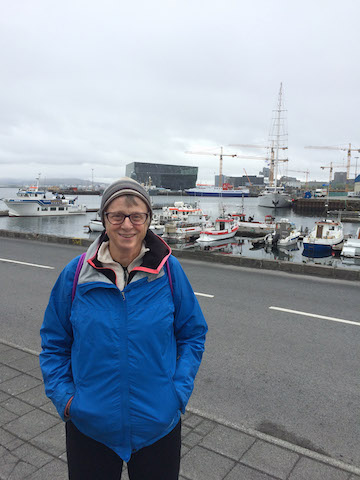
|

|
|
Atlantic Puffin at Akurey Island |
Swimming Atlantic Puffins at Akurey Island |

|
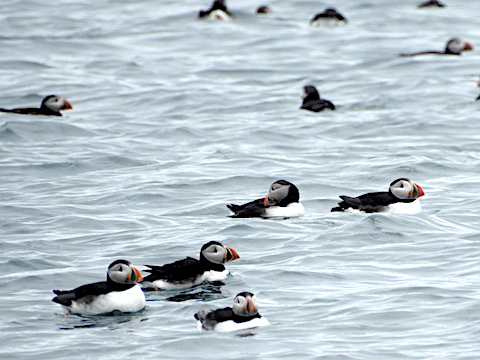
|
|
|
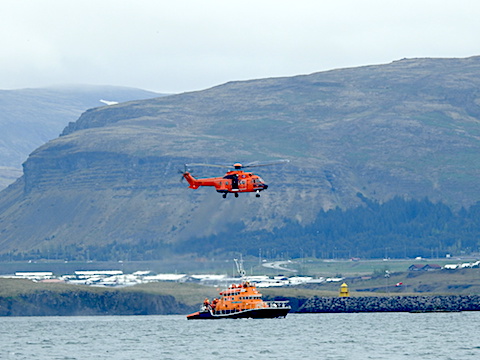
|
|
Gail and Icelandic horses at Laxnes Farm, where we picked up tourists. The guide said the Game of Thrones used horses from this farm. |
Þingvellir National Park: This cliff marks the eastern edge of the North American tectonic plate |
|---|---|
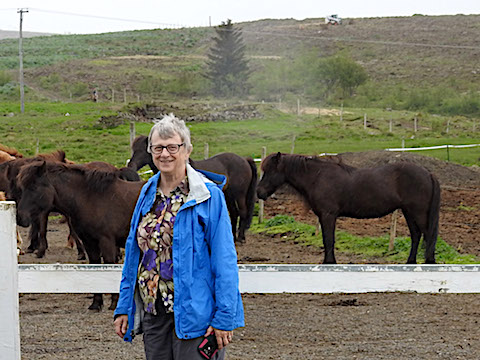
|
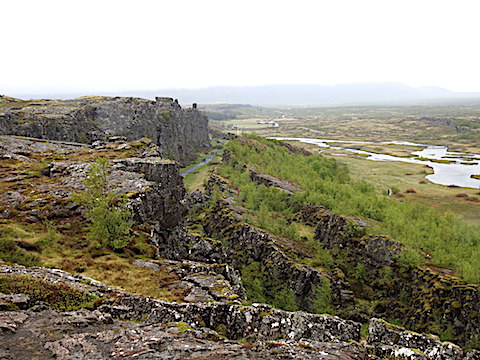
|
|
Looking the other direction |
Some tourists at the Þingvellir National Park |

|
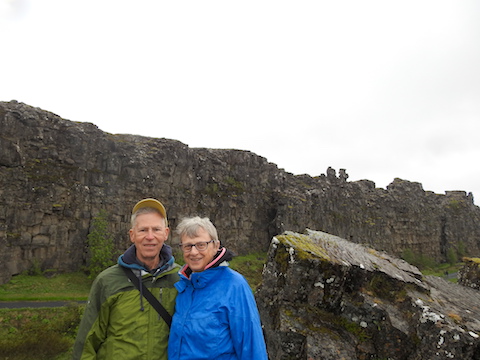
|
|
Löberg - the Law Rock - where the Law Speaker stood to recite the laws |
Redwing bird at Þingvellir declaring its version of the law |

|
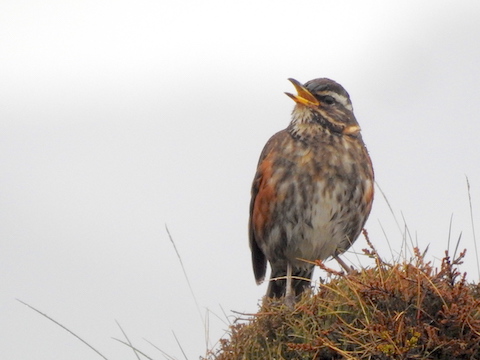
|
In Icelandic, Gullfoss is said to mean the Golden Waterfall. The tourist bureau photos show it in sunshine with rainbows in its mist. It would be nice to see it that way.
|
Gail at Gullfoss |
Gullfoss is a popular tourist site, even without rainbows |
|---|---|
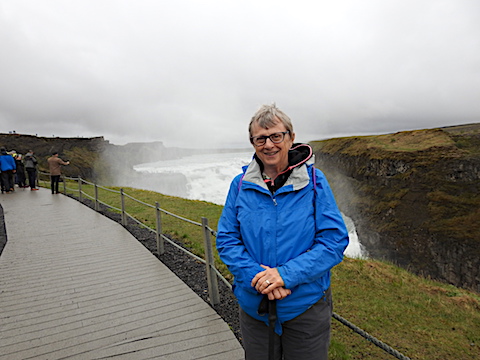
|
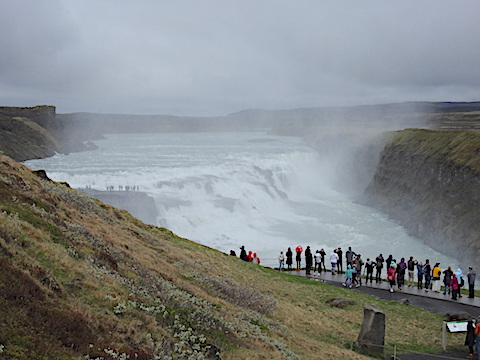
|
|
Gullfoss, the Golden Waterfall |
Looking downstream into the canyon |

|

|
Can you imagine how startled the Vikings were to find pools of water that would scald their skins and explode into fountains? All earth's geysers get their name from Iceland’s Great Geysir. Etymologically, the word has it roots in the Old Norse word “geysa” which means to gush or rush forth.
|
The original Great Geysir, which no longer erupts |
A colorful, and hot, geothermal pool |
|---|---|
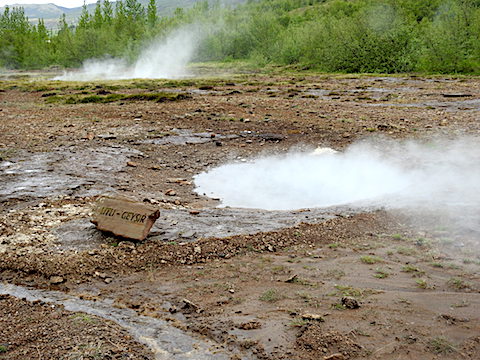
|
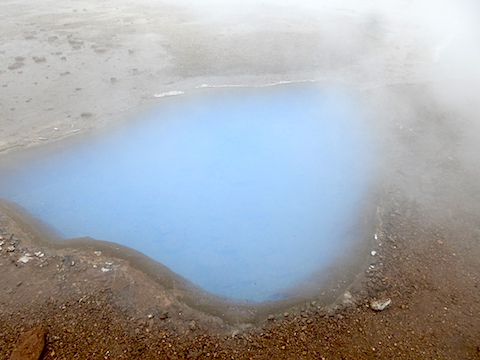
|
|
The pool of the Strokkur (Icelandic for “churn”) geyser |
The start of Strokkur’s eruption |

|

|
|
Strokkur’s eruption |
The peak of the eruption |

|

|
Scotland
|
Gail’s father’s parents came from Scotland and, after WW II, they
moved back to Scotland, where they died. We had the address where
they grew up from the Scottish census and the last place they lived
from the return address on an envelope. We wanted to see where they
came from as well as see a little of the countryside and historic sites
of Scotland.
We chose the town of Grangemouth for our base of operations because it was near the historic castle at Sterling, near the town of St. Ninians where Gail’s grandfather, George Paton, grew up, and because it was the town where George and Bella Paton lived until they died. We stayed at the Grange Manor Hotel. It was great! The room was spacious and the bathroom even had a tub. The breakfasts were full meals, actually two full meals. First there was a breakfast buffet with a variety of good stuff and then after that we got a hot cooked breakfast from the kitchen. It also had easy access to the M9 freeway. This is the story of driving in Scotland while American. We had no serious mishaps, but they do drive on the left side of the road. We have driven on the left on St. John in the Virgin Islands, but there the driver sits on the left and you would be lucky to get up to 20 mph. In Scottish cars, the driver sits on the right and traffic is a lot faster than 20 mph. Our rental was a sporty Honda Civic. It was hard for us to bend enough to squeeze in the doors, but the arrangement of the brake and clutch were the same as on American cars. Now, when the driver is accustomed to sitting on the left, he or she expects the left side of the car to be close at hand. That’s not how it is when driving from the right. Numerous times our left wheels ran on the shoulder or against the curb because we misjudged the location of the side of the car. |
|
The Grange Manor Hotel |
Our room |
|---|---|
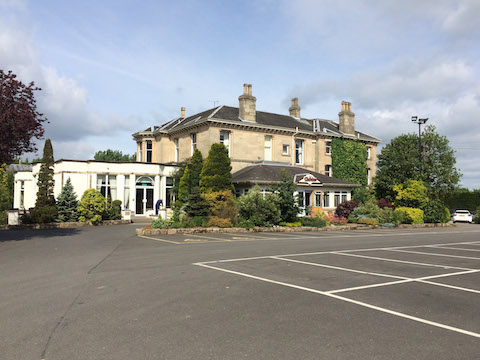
|
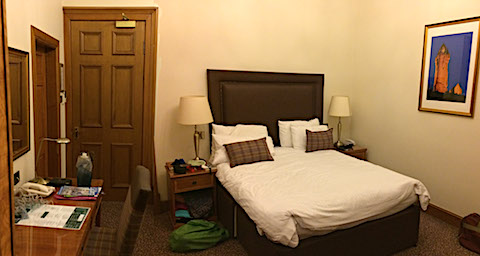
|
Sticking to a historical theme, we also visited the remains of the Roman Rough Castle and of the wall built at the direction of the Roman Emperor Antonius Pius to protect Roman England against the northern tribes.
Near Rough Castle is the Falkirk Wheel, a sort of Ferris Wheel to lift boats from one canal to a much higher one. We arrived at the end of the day and did not see any boats actually lifted, but we did witness a rotation of the wheel.
We visited the Kelpies, 98-foot-high horse-head sculptures, representing dangerous, mythological water spirits.
|
At one of the Sterling Castle’s gates |
Formidable defenses |
|---|---|

|

|
|
The Great Hall of James IV, the largest building in Scotland at its time |
Interior of the Great Hall |
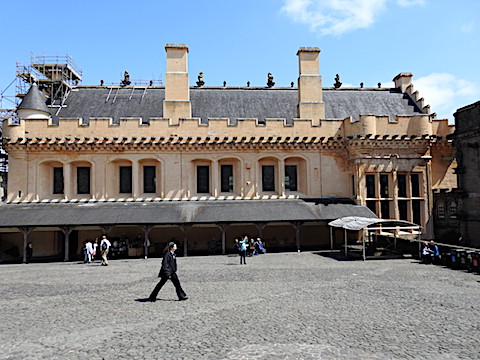
|
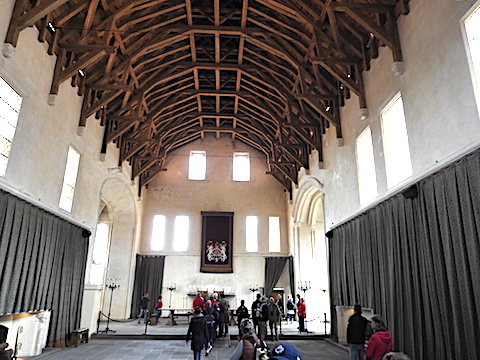
|
|
Life-sized statue of James V on the palace wall
|
Some of the Sterling Heads on the ceiling of the King’s Inner Hall. The portraits include Scottish and European royalty, Roman emperors, and mythological heros. |
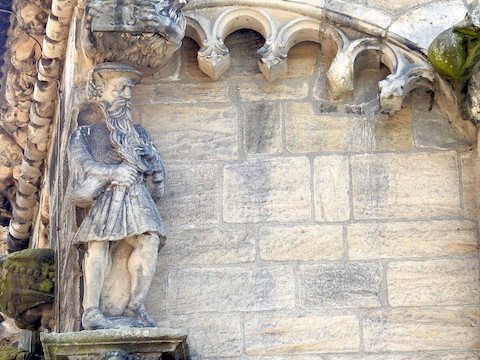
|
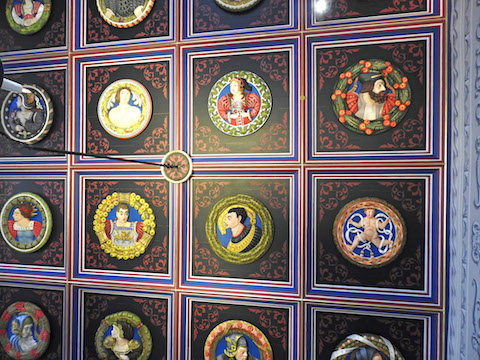
|
|
The Queen’s Inner Hall. |
More formidable defenses |

|

|
|
A Cannon’s view from Sterling Castle On the distant green hill is the 220-foot high monument to William Wallace |
|

|
|
|
|
Gail at the Antonine Wall |
|
The
wall constructed
for the Roman Emperor Anoninius consisted of a deep
ditch, a bank of dirt and stone excavated from the ditch, and a wooden
palisade on top of the wall.
It ran from the Firth of Forth on the east to the Firth of Clyde in the
west.
Constructed from 142 CE to 154 CE,
it was abandoned 8 years later. In 208 CE, it was briefly reoccupied
and then abandoned again. Now there is little to see. The palisade has
rotted away. The bank eroded. But the ditch still remains.
Sixteen forts were built along the wall to house the legions manning it.
The one at this location, called Rough Fort, was one of the smaller ones.
This fort was manned by Nervians, a powerful tribe from southern Belgium.
Nothing remains above ground to be seen.
|

|
| A rotation of the Falkirk wheel | |||
|---|---|---|---|

|

|
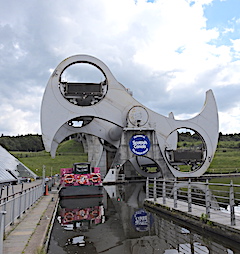
|

|
| The Kelpies at the Forth and Clyde Canal | Gail with the Kelpies |
|---|---|

|

|
While we were at Sterling, we drove to Bridge of Allan, but did not know where to look to find where Sarah McLean had lived.
Next we tried to find St. Ninians. Our Scottish map showed the town, but lacked the detail to tell us which streets would get us there. The GPS system in our rental car did not recognize the name of the town! Other than that the GPS was pretty good and easy to program. What happened? After returning to Maryland, we learned that St. Ninians had been incorporated as a district in Sterling and no longer existed as a separate town. A lost opportunity.
Neither GPS nor Google could tell us where Grange Street in Grangemouth was located. We visited the local library where we learned the street had been eliminated and an industrial park built where it had been. The librarian did have a book that showed an old photo of Grange Street. In the Grangemouth Advertiser we found notices of the deaths of George and Isabella, but there was no information about what cemetery they were buried in.
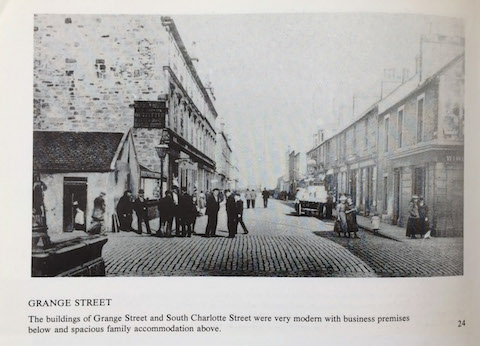
|

|
Sweden
The idea of holding a family reunion of the descendants of
Olof Andersson and Eva Anderssdotter
at the ancestral farm in Sweden was first
proposed at the 2016 family reunion in British Columbia.
After nearly a year of planning,
it came true in June 2018.
My grandfather, Victor Emanuel Holm, was the grandson of
Olof and Eva and the son of their son Fredrick Olofsson,
who had remained in Sweden when three of his brothers
emigrated to America.
Gail and I participated in the gathering and then took
advantage of our presence in Sweden to see cousins to whom
I’m related through my grandmother, Frida Sörqvist,
and to do more sightseeing in this picturesque part of Sweden.
|
We chose to stay in the resort town of Fjällbacka because we knew that it was only about 30 kilometers from the location of our ancestor’s farm. Brad had been there decades ago and knew it was good place to use as a home base, with hotels and restaurants. It is a picturesque village on the rocky shore of the Skagerrak strait. The actress Ingrid Bergman spent her summers here and, when she died, had her ashes scattered near the island her cottage was on. The village is featured in a series of murder mysteries by Camilla Läckberg. |
The following cousins attended from America:
|

|

|
|
One of the challenges we faced in planning our reunion was that
initially none of us really knew precisely where the farm was located.
In her book
The Descendants
of Olof and Eva Andersson, Helen Holm Hobert
had written,
“Olof Andersson was a farmer who owned land at Heljebo near Lake Bullaren, the
largest lake in Bohus Län”.
In his memoir, Victor
Holm had written that farm Helgebo was in Mo Parish on the east side
of Lake Bullaren at the foot of Kynne Mountain.
The farm’s name did not show up in a Google map search.
However, from the description, a Swedish cousin of Al was able to locate
it with a Swedish online map program. We also found the farm -
named Häljebo - in topographical maps of the area.
Its location is circled in the map image on the right.
To help future generations to find Häljebo, we note that its latitude and longitude are 58º 39' 31.16" North, 11º 34' 34.64" East. Laila Falk put us in contact with the current owner of the farm, a German, to make sure that we had permission to visit. She also arranged for the previous Swedish owner of the farm, Rolf Olausson, to give us a tour. In his later days, Fredrick Olofsson moved to another farm, named either Hällekårret or Hällejäret and that is where Brad’s grandmother grew up, but we were not able to locate it on our maps.
Another challenge the Americans faced was getting in touch with Swedish relatives. This side of the family had lost contact. Once again Laila Falk was able to provide the necessary information. Eunice corresponded with our newly found relatives and some of them were able to join the reunion.
Laila Falk also arranged for us to get see the interior of Mo Kyrka, the church that our ancestors attended, and to attend a church service at Naverstads Kyrka, where Victor Holm was baptised. |
|
Thursday, June 14, was our day of travel and of checking in at Villa Evalotta, our hotel. Brad and Dan came from a journey up Norway’s coast with the Hurtigruten Cruise Line so they flew south to Oslo and drove down from there. Cynthia, Eunice, Mike, and Jeannie flew directly to Oslo from Minnesota. Gail and Al flew to Göteborg from exploring her family’s locations in Scotland.
We stayed in Evalotta’s Villagården building and had all but one of the rooms. It had a large dining and living room, a kitchen we could use, and WiFi. There was even a large-screen TV in the living area where we watched some World Cup matches.
There is a world heritage location at Tanum with petroglyphs created somewhere between 1800 to 500 BCE by the bronze-age inhabitants of the area. We saw many petroglyphs, which had been colored red by the museum folks to make them more visible. I wonder if our ancestors ever saw them.
While riding on a rural road, Al even saw a moose in a deep, wooded gully alongside the road. There were other activities, such as fishing, taking a cruise among the islands, or spending time in Göteborg, that we could have enjoyed, but did not have time for.
|
Fjällbacka’s harbor seen from our hotel |
Fjällbacka’s waterfront seen from Kungsklyftan (The King's Cleft) |
|---|---|
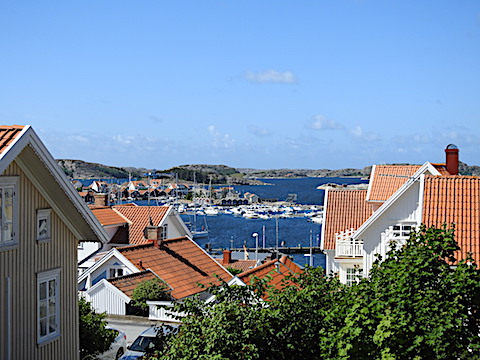
|
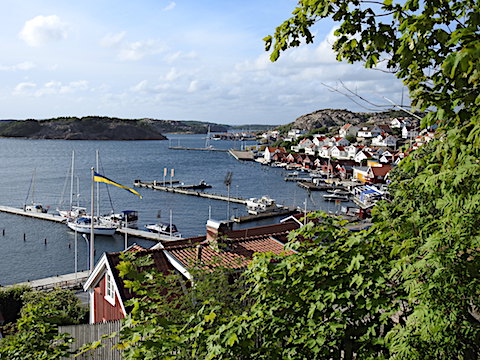
|
|
Gail walking in Kungsklyft above Fjällbacka |
Eunice and Mike planning our itinerary |

|
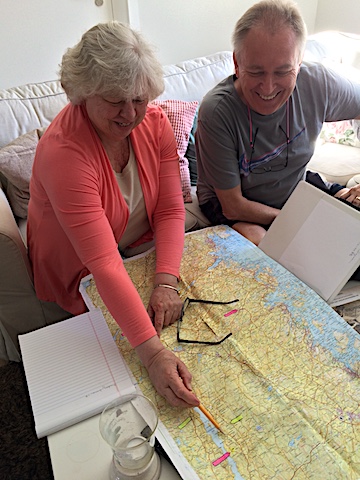
|
|
Typical landscape in this region, fields surrounded by steep-sided rock hills crowned by trees |
Fjällbacka’s Waterfront
|
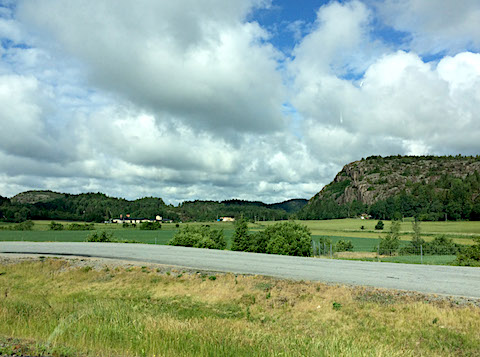
|
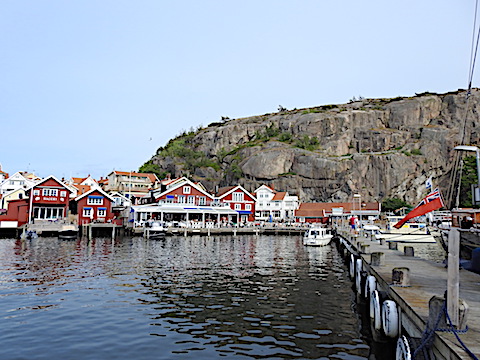
|
|
At the Bronze-age Petroglyph site at Vitlycke
|
Ships and the men crewing them were a common subject of the petroglyph artists |

|

|
|
Dancing Girl Petroglyph |
Our bronze-age ancestors were not prudish |

|
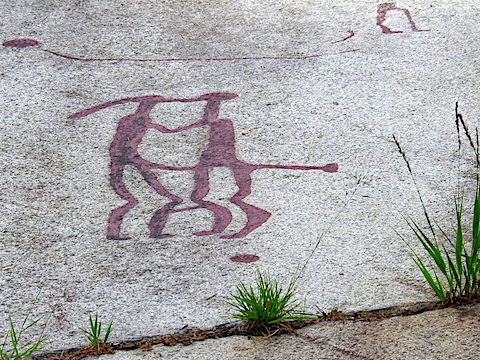
|
Of course, we visited the churches and churchyards that are associated with our ancestors. On Friday, we went looking in the churchyards at Kville, Mo, and Naverstad for gravestones of our relatives. In Sweden, there are no municipal or private cemeteries. Everyone has to be buried in the churchyard. We knew that Fredrick Olofsson had been buried at Kville, but could not find his gravestone. Later we learned that if a grave is not kept up, the stone will be removed.
Mo Kyrka was the home church for Olof Andersson’s family. It is on the west side of Lake Bullaren, so the family probably took a boat across the lake on Sundays. The stone for Fredrick’s older sister, Anna Maria Långström, was still in place at Mo Kyrka and someone was even planting fresh flowers for it. On Saturday, we took Monica and her family to see her ancestors grave.
Al’s grandfather, Victor Emanuel Holm, was baptised at Naverstads Kyrka in the middle of January 1879. We don’t know why this was not done at Mo Kyrka. Maybe the weather was too stormy to cross the lake.
Sunday was our day to see the inside of Mo Kyrka and to attend a 2PM service at Naverstads Kyrka. The visit to Mo Kyrka went very well thanks to Brita. When we got to Naverstads Kyrka, we found a handful of parishioners filing out. The time of the service had been changed without our knowing. However, the pastor and organist stayed late to lead us in three Swedish hymns.
|
Mike and Cynthia at Kville Kyrka, where Fredrick Olofsson was buried
|
Eunice, Brad, Mike, Cynthia, Dan, and Al at Mo Kyrka, the home church of Olof Andersson’s family |
|---|---|
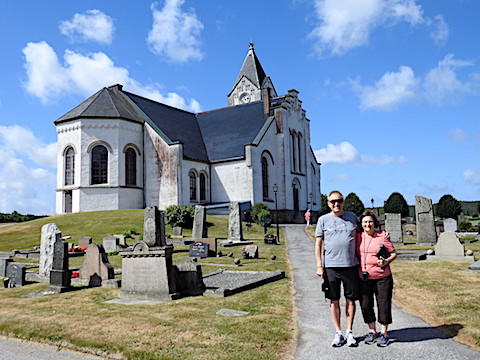
|

|
|
Monica and her family at the grave of her great-great-grandmother, Anna Maria Långström, in the churchyard at Mo Kyrka
|
Inside Mo Kyrka: Dan, Brad, Gail, Al, Laila Falk, Brita Ivarsson, Mike, Jeannie, Eunice, and Cynthia |
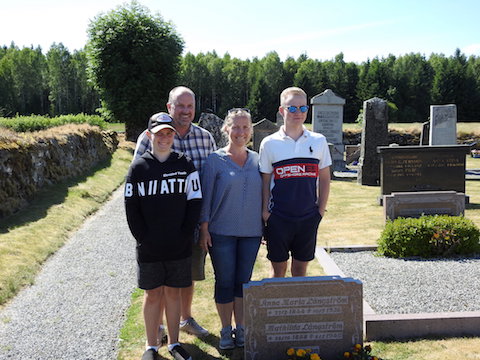
|
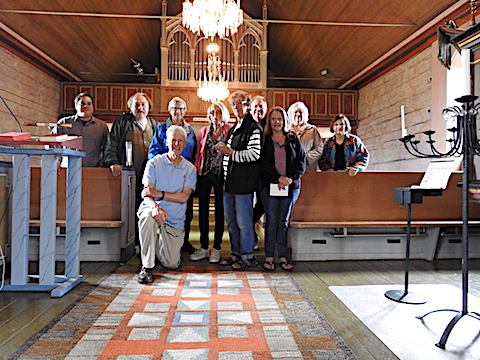
|
|
Naverstads Kyrka with its separate 1669 bell tower |
Ceiling art, organ pipes, and paintings of Jesus and his Disciples in Naverstads |

|
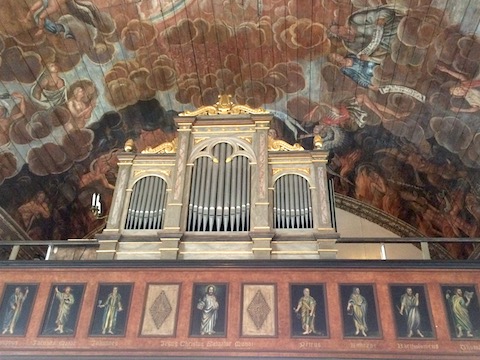
|
On Saturday, Monica and her family, and Lars-Olof and his group joined us. We had lunch and got to know one another. Later we took our newly found cousins to see Häljebo and the Mo Kyrka.
|
Gathered for our Saturday lunch |
Knud and Brad comparing mustaches |
|---|---|

|
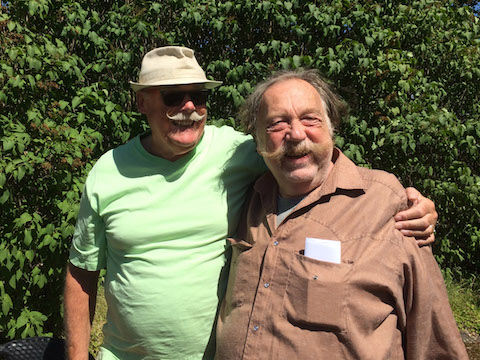
|
|
Linda, Gerd, Knud, and Per |
Markus, Ulrika, and Lars-Olof |
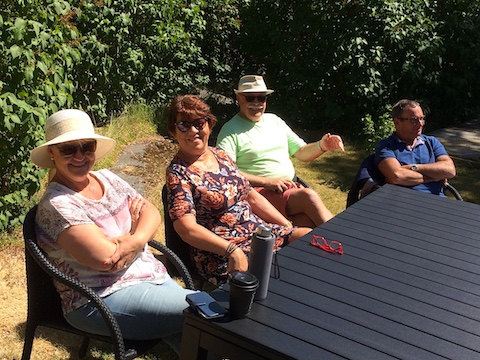
|
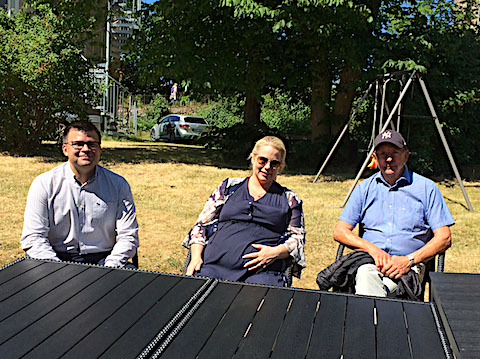
|
|
“Official” photo of our reunion, on the steps of the Villagården building |
|---|
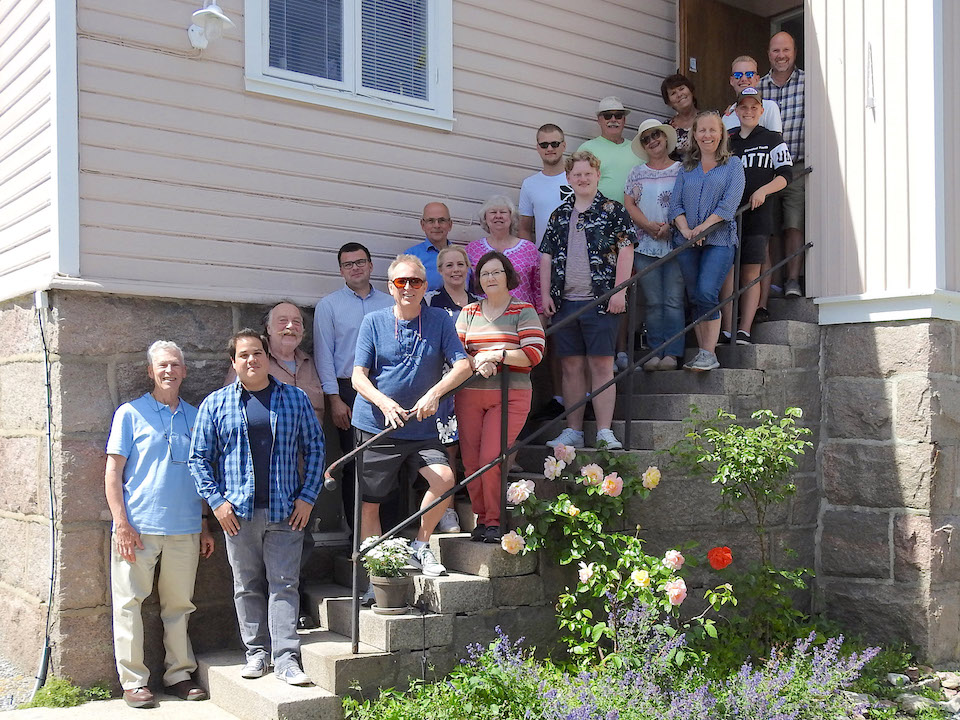
|
|
Dan, Mike, and Eunice at the approximate location of Olof Andersson’s home at Häljebo |
Rolf shows us a footing stone for the old home
|
|---|---|
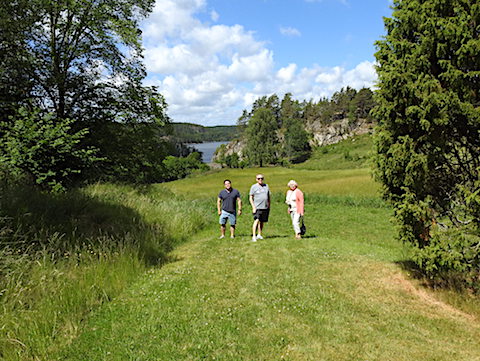
|
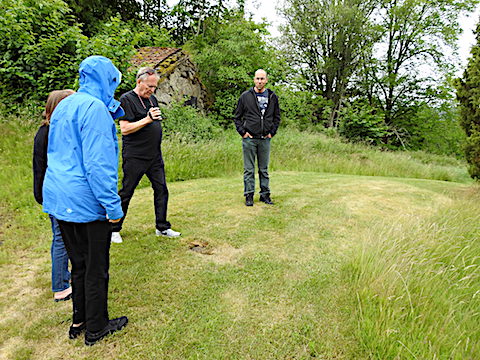
|
|
The root cellar may date from when our ancestors lived here, even though the old home is gone |
Rolf’s old photograph of Victor and Jenny Holm with his father and grandmother gave us assurance that we had found the right farm |
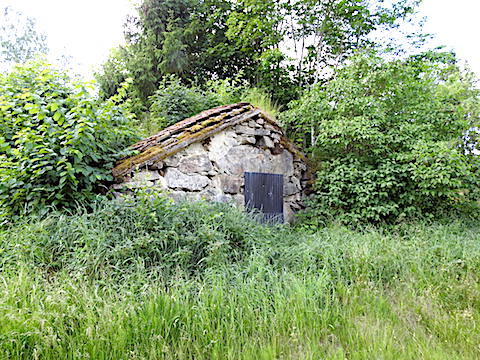
|

|
|
Cousins at the location of the old home |
Dan, Al, Mike, and Cynthia with the farm’s field behind |
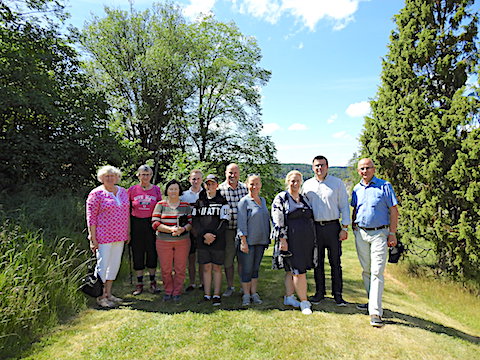
|
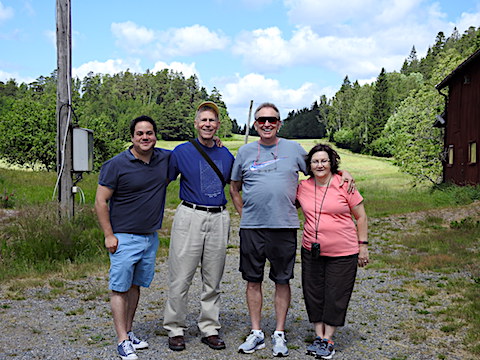
|
|
The farm buildings today
|
At the site of Häljebo’s old house with the new one in the background. The new one has a color common to many Swedish houses. |
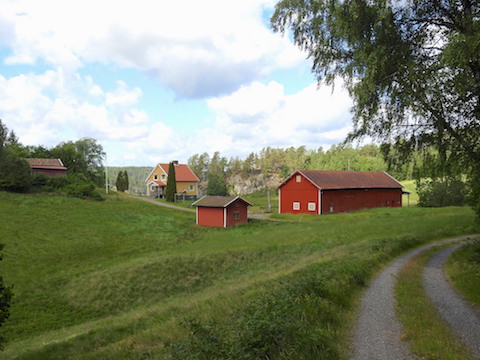
|
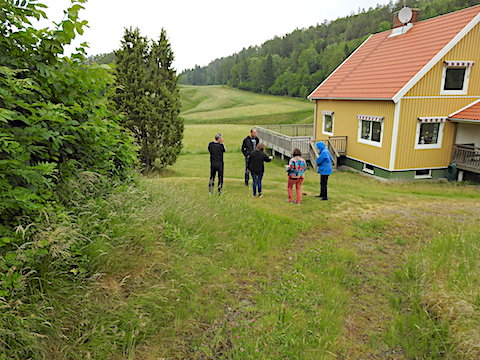
|

Between leaving Villa Evalotta and checking in at the bed and breakfast, Gail and Al visited locations where his grandmother and great-grandfather were born, but no buildings remain from those days. We also visited the Svenneby Gamla Kyrka. Swedes began building this church in the 1100s. In accordance with the beliefs of the time, it does not have windows on the north side. Its bell tower stands atop a cliff behind the church.
In Dingle, we stayed at Ängens Gård, a bed and breakfast built in a converted barn. The room was spacious with lots of storage, and breakfast was complete - rolls, omlet, tasty Swedish pancakes, cheeses, meats, bacon, fruit, yogurt, cereal, and more - even when only the two of us were there in the middle of the week. In Sweden there are no laundromats, so the kind owner even did our laundry for us when we were running out of clothes.
| The old church in a scenic location | No windows on the north side of Svenneby Gamla Kyrka |
|---|---|
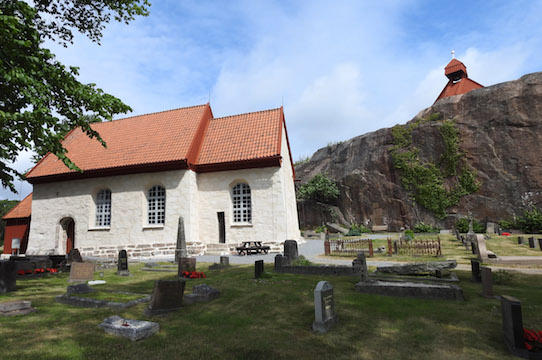
|

|
|
The Bed and Breakfast in Dingle |
At the hitching rail |
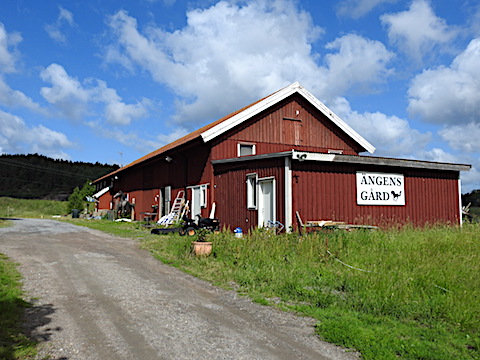
|

|
On Tuesday, Eva-Lisa Lundgren, my second cousin once removed, and her husband Åke took us visiting family history locations. We went first to Svartborgs Kyrka, where Frida’s father, Carl Alfred Sörqvist, was baptized and also where Victor’s grandfather Olof Andersson was baptized. Eva-Lisa's great-grandmother, Mathilda, is buried there. After that they took us to Uddevalla, first to the cemetery where Carl Alfred Sörqvist and his wife Hilma are buried. Next we went to Björkebohagen their last home (58º 22' 28.5" North and 11º 58' 1.2" East), but the only thing that remains there now is an old apple tree. Our final family history stop was Bokenäs Gamla Kyrka. This church dates from the Early Medieval Period, possibly even the late eleventh century, and it is also the final resting place of Al’s great-great-great-great-great-grandmother’s brother, Gabriel Gustaf de Moine. He is buried under the floor of the church in 1751.
After exploring the family history locations, Eva-Lisa and Åke treated us to a delightful lunch of salmon, potatoes, dill sauce, thin bread, cheese, and green salad. Finally, they took us back to Dingle via a scenic coastal route from Kungshamn to Hamburgsund.
|
Svarteborgs Kyrka, sitting atop a hill |
Nearly every church had a row of paintings of Jesus and his Disciples |
||
|---|---|---|---|
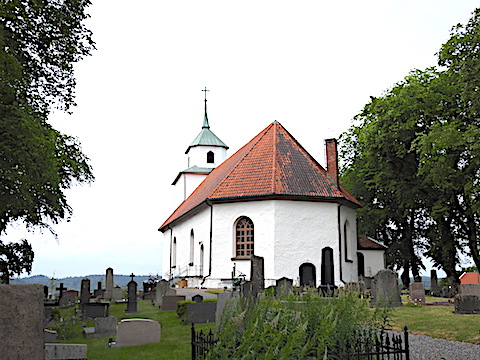
|
|
||
|
Eva-Lisa at her great-grandmother’s gravestone
|
Eva-Lisa, Åke and Al at the site of Björkebohagen. the vanished last home of Carl Alfred and Hilma |
||
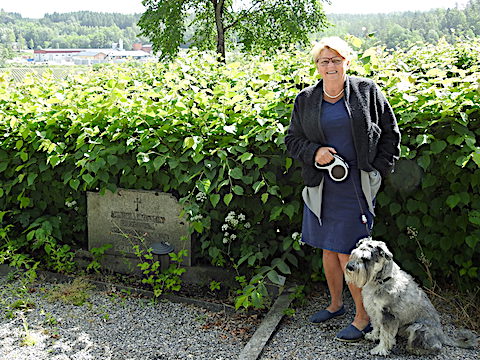
|
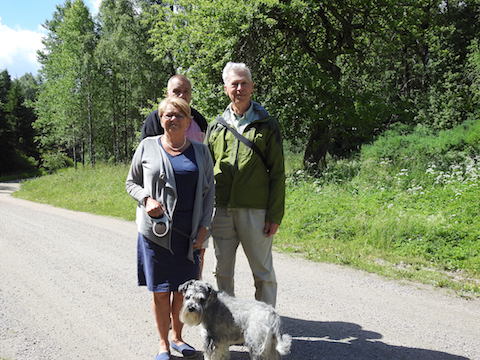
|
||
|
Gravestone for Carl Alfred and Hilma Sörqvist |
Where the Sörqvist stone is found in the Eastern Cemetery in Uddevalla |
||
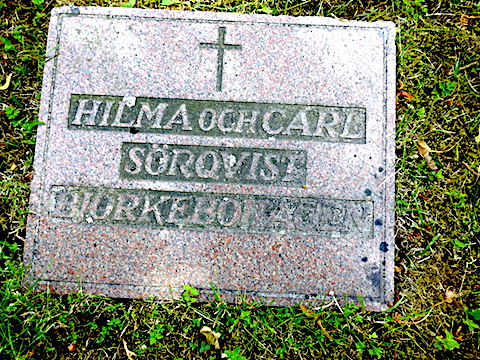
|
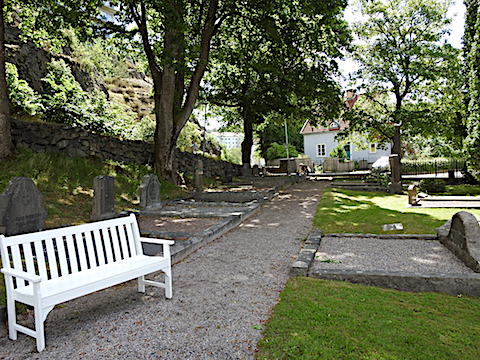
|
||
|
Bokenäs Gamla Kyrka, seen from the south This church also has no windows on the north side. |
A model ship hanging in Bokenäs Gamla Kyrka Many churches in Bohuslän have these ships. |
||

|
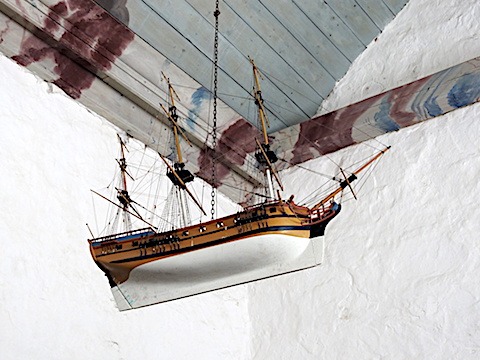
|
|
Based on archeological excavations, a Bronze-age home looked like this |
“Sun Horse” at Fossum, left uncolored so the real etching is visible |
|---|---|
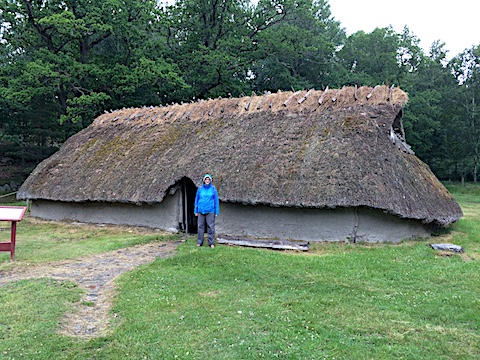
|

|
|
Either a bronze-age calendar, four rows of seven dots with an 29th one above or a bronze-age balloon salesman |
The “Spear God” at Litsleby, maybe a precursor of Odin Note the footprints at the left, maybe for a god too powerful to portray |
|---|---|
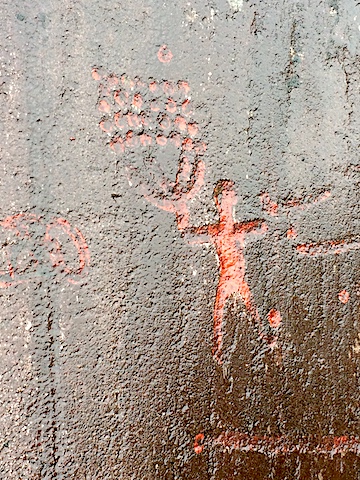 |
 |
|
The catamaran ferries to the Koster Islands |
Hiking along the shore of South Koster Island |
|---|---|
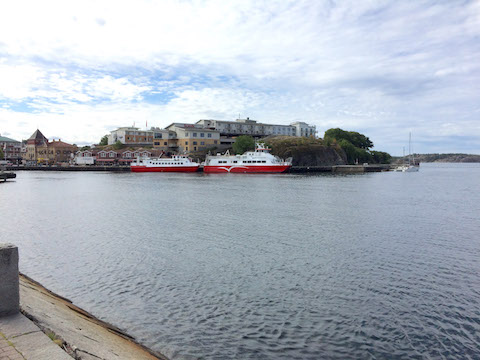
|
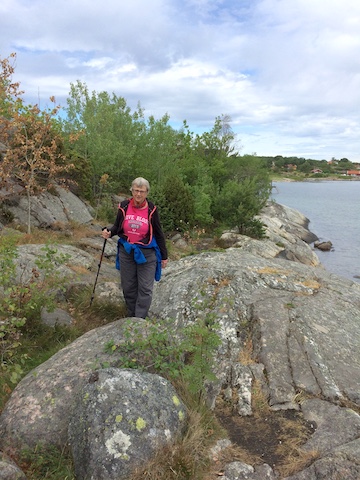
|
|
A Common Tern, frozen in flight at Ekenäs |
Strömstad’s riverfront, the tower of its city hall in the background |
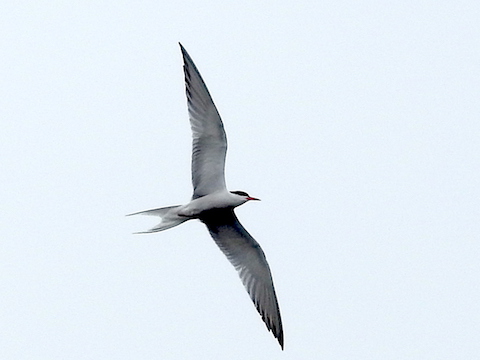
|
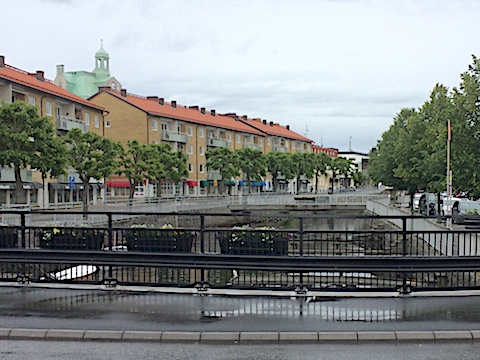
|
The next day Britt-Marie took us to visit Tjörn and the scenic shore towns of Klädesholmen and Skärhamn. The weather turned sunny that day to make for a better experience.
Britt-Marie also gave us old family photos and letters sent by Victor Holm and Aurora Holm to Swedish relatives. Perhaps the most interesting of the family history information was that Al’s grandmother’s grandmother had been sent to debtor’s prison in 1876. Her husband had run off to Norway and it was hard for her to raise her children.
|
At Göteborg’s canal |
Looking the other direction on the canal |
|---|---|
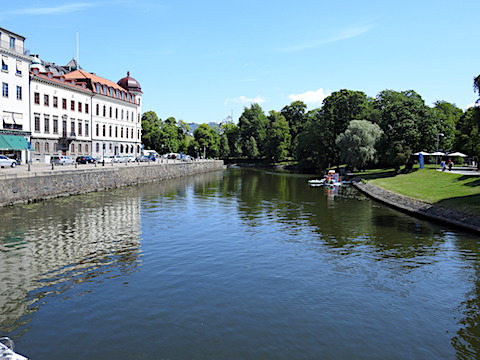
|
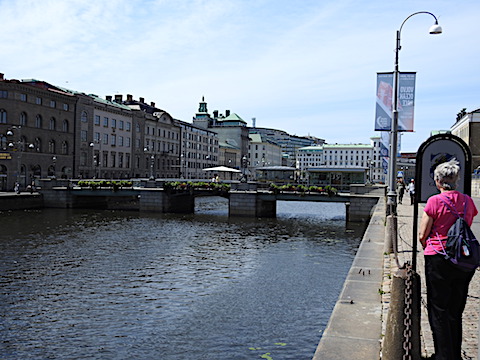
|
|
Remains of a Viking trading ship at the Stadsmuseum |
Barken Viking hotel ship on the Göta River and the Lipstick Building |
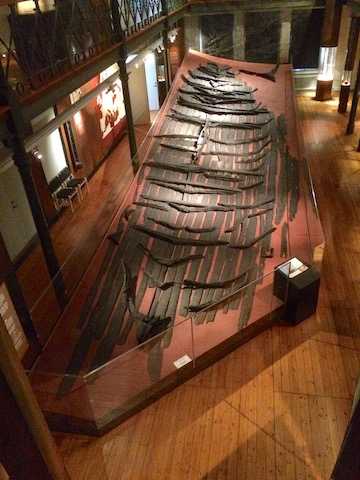
|
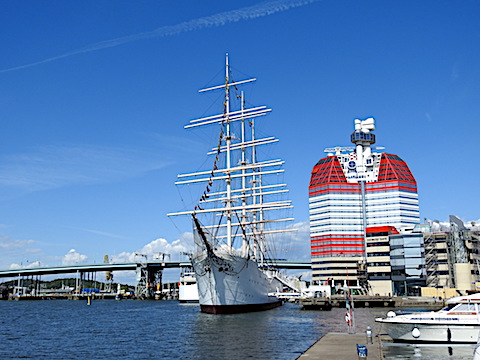
|
On Monday morning, June 25, Gail and I caught a 6:35am SAS flight to go to Germany.

|
We
visited Ingrid and her family
in Gelsenkirchen in 2012, and it was time to visit again.
Felix was now seven years old, and we had not met the new “babies”,
Marta, five, and Leander, three. As in 2012, Ingrid’s parents, Klaus and Ilse,
put us up in a spare room and fed us, fed us very well.
We relaxed a lot, hiking on trails, eating, sleeping, sitting in the garden, doing laundry. In addition, Ingrid arranged for some memorable adventures. We visited the Neanderthal Museum in Mettmann, Germany, which is at the site of the first Neanderthal skeletons were found in 1856. We hiked to and climbed on Externsteine, a distinctive series of free-standing rocks. We sailed on, and some of us swam in, Steinhuder Meer, the largest lake in northwest Germany. We visited an art installation called Der Berg Ruft. We watched Germany play Korea in the World Cup. That did not turn out well for the home team, but we still had BBQ in the garden afterwards. We also visited the St. Nicolai Kirche in Bakede - now incorporated into Bad Münder - and found more records of Gail’s mother’s ancestors. Holger has a Miata convertible for his commute to work. Cool! |
| Marta enjoys the pizza her grandfather made | It looks like spaghetti, but it’s ice cream |
|---|---|
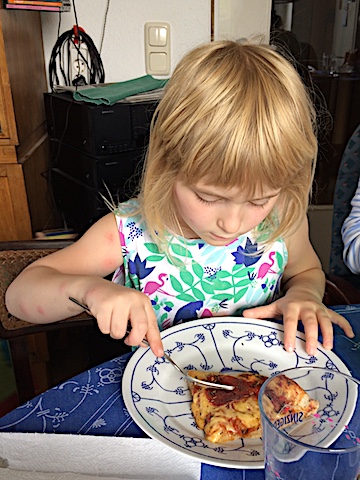
|
This one is simple, just the ice cream, bananas, a wafer, and
fruit sauce. They can be elaborate, shaped to look like
a plate of spaghetti with tomato sauce,
an eggs sunny-side up breakfast, or some other non-ice cream
dish. A good reason to visit Germany.
|
|
Felix and a Neanderthal model in modern clothes |
Marta and a Neanderthal girl model |
|---|---|

|
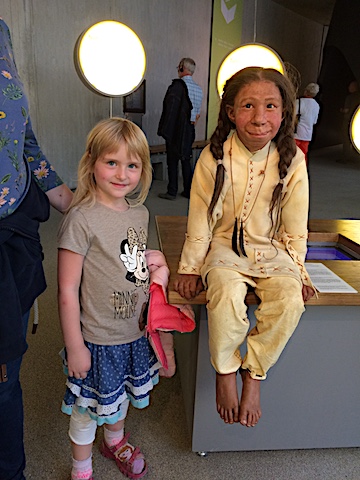
|
|
Excavating a skeleton? Or digging in a sandbox? Both? |
Where the Neanderthal bones were found, since quarried away |

|
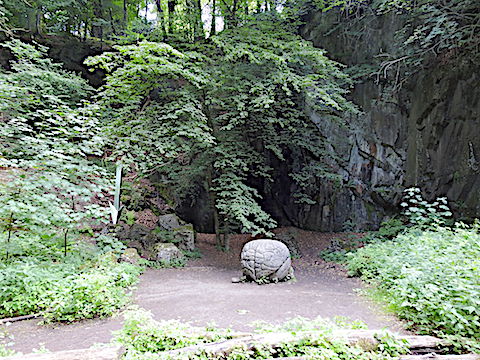
|
|
“Recreated” Tarpan horse |
Marta discovered this strikingly yellow spider along the trail |
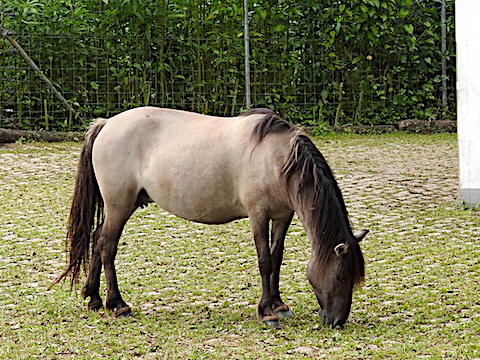
|
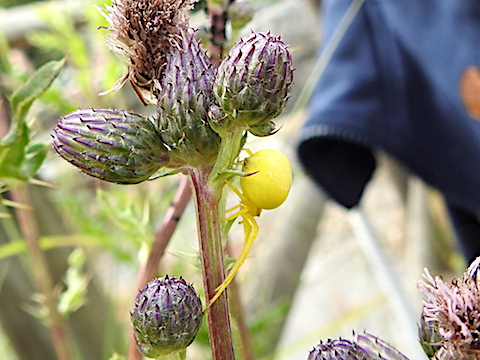
|
|
Wearing the right colors is important |
How does this work? Leander soon found out |
|---|---|

|

|
|
Dressed for victory ... |
but the German team is not living up to expectations |
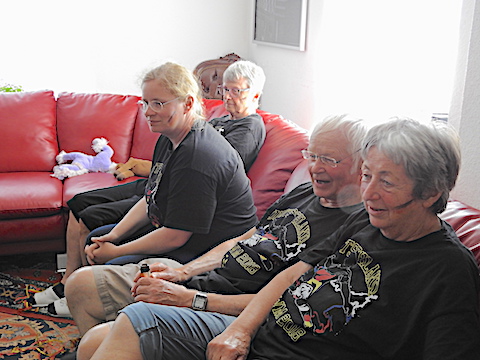
|

|
|
Gail and Al at Externsteine |
Ingrid and the children at Externsteine |
|---|---|

|
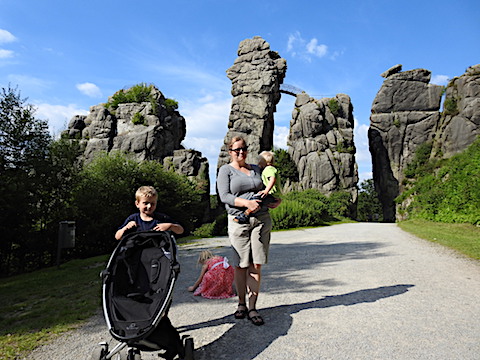
|
|
Felix and Marta raced to the top of the rock, leaving Al panting behind |
Felix, Marta, and Gail descending from the top |

|

|
|
Relief carvings in Externsteine’s stones (photo by Ingrid) |
What could be better than a large sandbox? A sandbox suspended in the air |
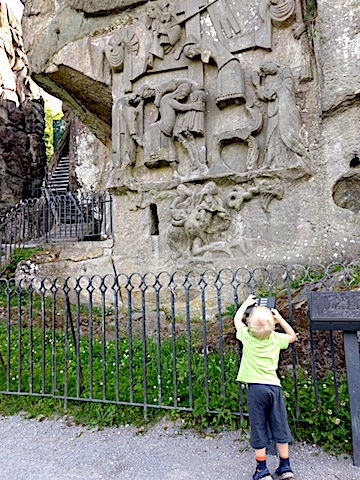
|
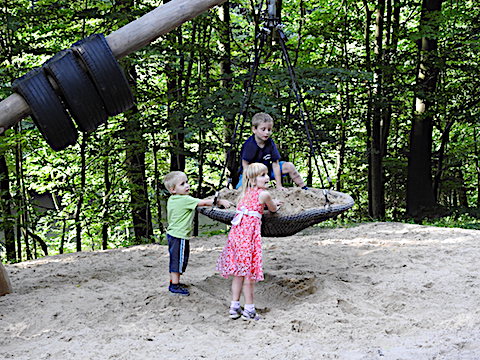
|
Steinhuder Meer is the largest lake in northwest Germany (12 sq. mi., about 40% the size of Loch Lomond), but is very shallow, averaging only 4.4 feet. It has two islands, Wilhelmstein and Badeinsel. In the 1700s, it was on the border of two warring German states, and in 1765, William, Count of Schaumburg-Lippe, built a fortress on Wilhelmstein. Badeinsel is reachable by a bridge and has a swimming beach.
Only a few ferries are licensed to use an internal combustion engine on the lake. It is delightful to see electric boats leisurely crossing the water. There are many sail boats, and paddle boats shaped like cars are available for rent.
|
Buildings in the tourist area of Steinhude are picturesque and old |
Ingrid found a stork at Steinhude for Al to photograph |
|---|---|
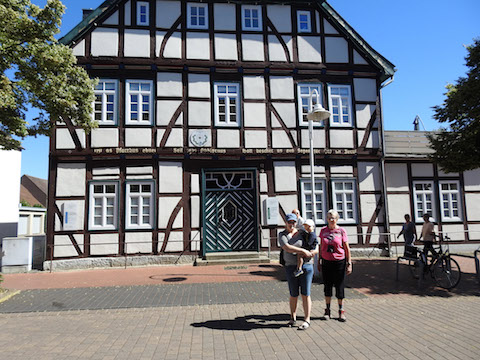
|
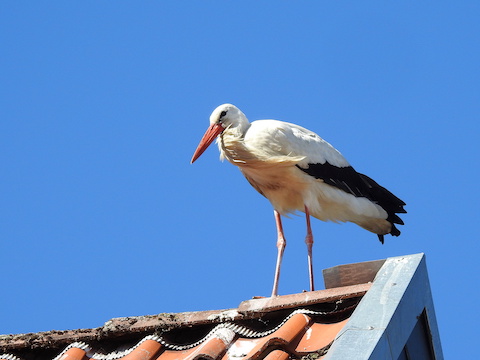
|
|
The fleet of beautiful boats that ferry passengers to Wilhelmstein |
Ingrid, Holger and the kids sailing to Wilhelmstein |

|
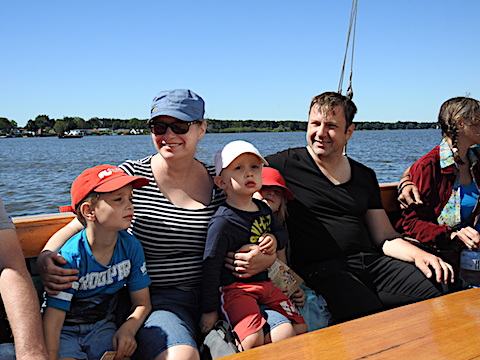
|
|
Wilhelmstein’s fort |
The view from on top the fort |
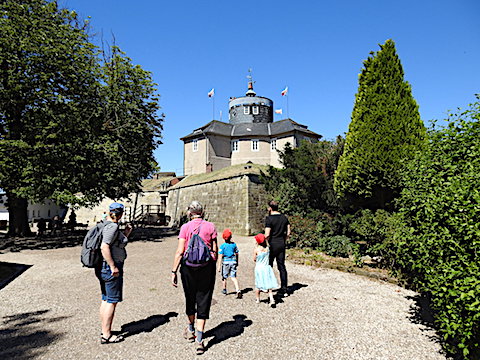
|

|
|
At Badeinsel, going to check the buoy marking the edge of the swim area |
A Great Crested Grebe on Steinhuder Meer |
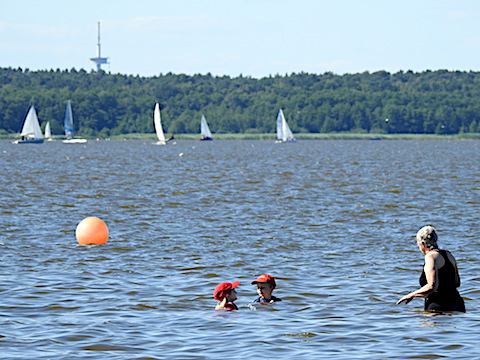
|
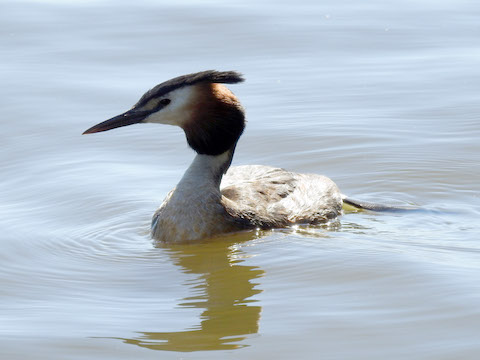
|
|
Walking along the Steinhude Nature Reserve |
Transportation for tourists |
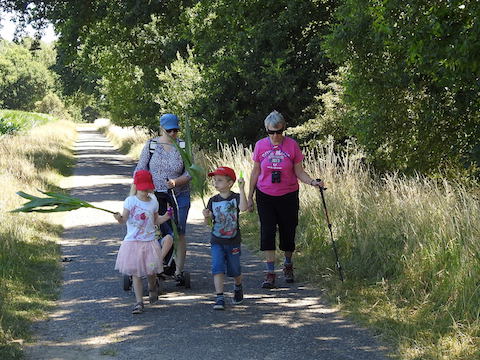
|

|
|
The family with one of the many life-sized dinosaur models |
Some of the fossil footprints |
|---|---|

|
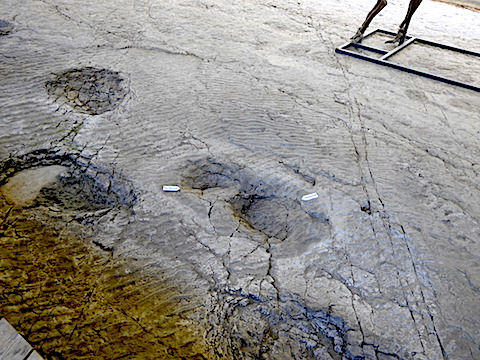
|
|
Felix works to free a model fossil from a fake rock |
|

|
Gail’s maternal ancestors attended St. Nicolai Kirche in Bakede before they came to America. The village of Bakede is now incorporated into the larger town of Bad Münder. This town is southwest of Hanover and just a little north of Hamelin, the Pied Piper town. Bakede’s latitude and longitude are 52º 12' 36" North and 9º 23' 21" East.
We found and photographed records of Hennies family marriages, births, and deaths in the church’s register books. The church administrator said it is good that we came now because in the future the books will be sent to an archive. She also told us that this church has no churchyard where we might find tombstones for family members.
|
St. Nicolai Kirche in Bakede
|
|
|---|---|
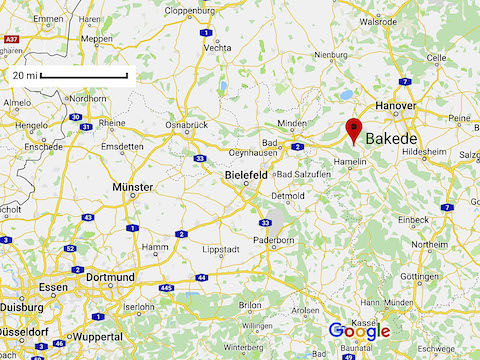
|

|
|
The birth record of Gail’s great-great-grandfather, Fredrich Ludwig Conrad Hennies, to Hinrich Hennies and Eleonore Stomeyer on September 17, 1788 |
After our visit to the church archives, we ate lunch at Frietags Hof in Bakede. Gail ordered Berliner Weisse beer. This is what she got. Not only colored green, but sweet. (Photo by Ingrid) |

The date beneath his name is his date of death, February 6, 1865.
|
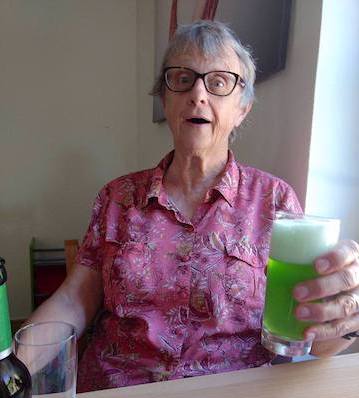
|
|
The old gas tank rising above its neighborhood |
Ilse, Gail, and Ingrid at Der Berg Ruft |
|---|---|
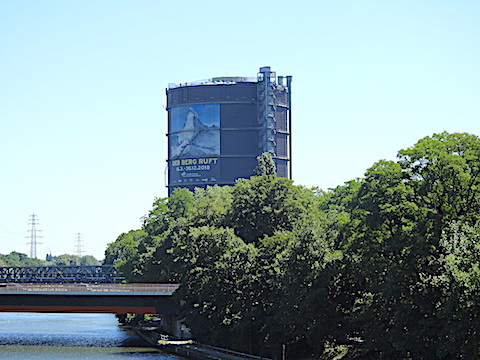
|

|
|
The view from the top |
|
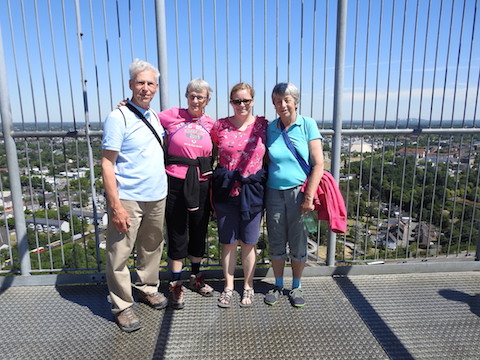
|
|
On the Slinky bridge |
Felix after his bike class at school |
|---|---|
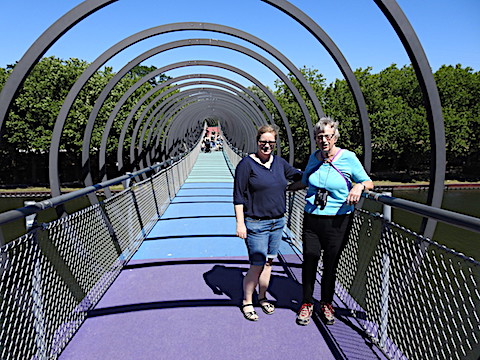
|
 |
|
Leander enjoys the wading pool of his Lebanese neighbors |
Marta also enjoys the pool |

|

|
|
Searching for a bird in Gelsenkirchen (Photo by Ingrid) |
Working on “up” and “down” at the playhouse (Photo by Ingrid) |
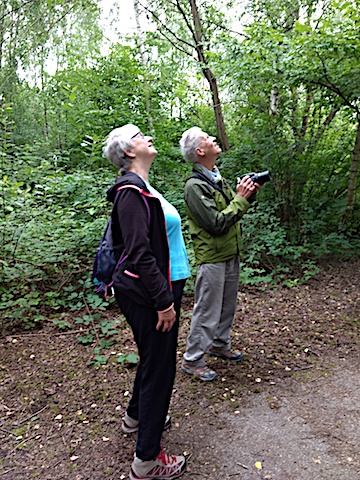 |
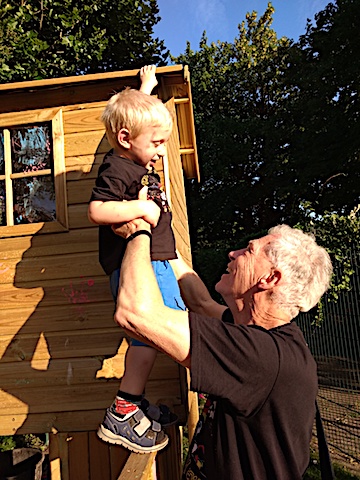 |
Responsible: Albert Holm
Created: 23 July 2018; Updated: 17 September 2025